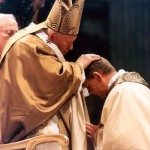 This week the United States Conference of Catholic Bishops made public its annual survey of newly ordained priests, conducted by the Center for Applied Research in the Apostolate (CARA), a Georgetown University-based research center. The Class of 2011: Survey of Ordinands to the Priesthood surveys the men being ordained priests for U.S. dioceses and religious communities this year.
This week the United States Conference of Catholic Bishops made public its annual survey of newly ordained priests, conducted by the Center for Applied Research in the Apostolate (CARA), a Georgetown University-based research center. The Class of 2011: Survey of Ordinands to the Priesthood surveys the men being ordained priests for U.S. dioceses and religious communities this year.
“One important trend evident in this study is the importance of lifelong formation and engagement in the Catholic faith,” said Archbishop Robert J. Carlson of St. Louis, chairman of the U.S. Bishops’ Committee on Clergy, Consecrated Life, and Vocations. “The role of the family, parish priest, friends, and youth ministry are evident in the results.”
Most of the findings weren’t all that surprising or noteworthy to me. However, there are three things that caught my attention:
(1) The new priests are a little younger. The average age of this year’s ordinands is 34. Not only that, but two-thirds of all the ordinands are 34 or younger. The religious order priests raise the average a little bit, as they also typically go through their postulancy and novitiate before beginning their seminary studies.
(2) Vocations come from larger families. Families with at least three kids are now considered “large families.” Seventy-seven percent of the new priests come from families with three or more children. In fact, 37% come from families with five or more children. It’s by no means a “cause and effect” thing, but the numbers here do not lie: Large, intact, faithful Catholic families provide the best possible soil for priestly and religious vocations.
(3) Websites help. Twenty three percent of all respondents to the survey said that their discernment was influenced by websites. Even more, 37% of religious order priests were so influenced. I realize this is a little self-serving, but the survey nonetheless suggests that vocation websites and blogs can be most helpful tools in fostering vocations.
For the complete report, click here.
Like this:
Like Loading...
 In reading the CARA report this week on the men who will be ordained as priests this year, I noticed that among those responding to the survey, the Dominicans and Jesuits tied for the most ordinations by a religious community this year with nine.
In reading the CARA report this week on the men who will be ordained as priests this year, I noticed that among those responding to the survey, the Dominicans and Jesuits tied for the most ordinations by a religious community this year with nine. This week the United States Conference of Catholic Bishops made public its annual survey of newly ordained priests, conducted by the Center for Applied Research in the Apostolate (CARA), a Georgetown University-based research center. The Class of 2011: Survey of Ordinands to the Priesthood surveys the men being ordained priests for U.S. dioceses and religious communities this year.
This week the United States Conference of Catholic Bishops made public its annual survey of newly ordained priests, conducted by the Center for Applied Research in the Apostolate (CARA), a Georgetown University-based research center. The Class of 2011: Survey of Ordinands to the Priesthood surveys the men being ordained priests for U.S. dioceses and religious communities this year. Every year at Easter Wednesday Mass we hear St. Luke’s account of Our Lord’s appearance to the two disciples on the road to Emmaus.
Every year at Easter Wednesday Mass we hear St. Luke’s account of Our Lord’s appearance to the two disciples on the road to Emmaus.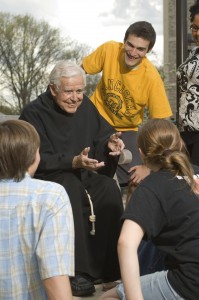 The
The 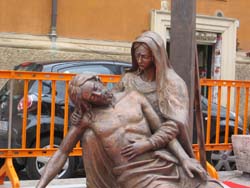 I just came across a story on Catholic News Service on Domus Dei, a company owned by the
I just came across a story on Catholic News Service on Domus Dei, a company owned by the 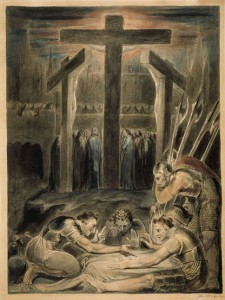 Here is a translation of the sermon delivered by Father Raniero Cantalamessa, O.F.M. Cap., preacher of the Pontifical Household, at the Good Friday liturgy in St. Peter’s Basilica in 2008.
Here is a translation of the sermon delivered by Father Raniero Cantalamessa, O.F.M. Cap., preacher of the Pontifical Household, at the Good Friday liturgy in St. Peter’s Basilica in 2008.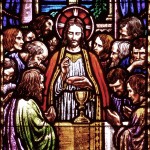 Today, as we celebrate Christ’s institution of the New Covenant priesthood at the Last Supper, I thought I would share with our readers
Today, as we celebrate Christ’s institution of the New Covenant priesthood at the Last Supper, I thought I would share with our readers 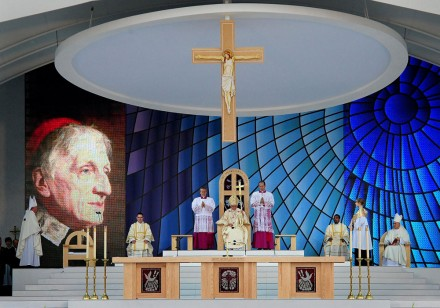
 Tired of all the bad news on TV and the Internet? If so, I have something just for you! Check out the following vocation-related stories from the past week:
Tired of all the bad news on TV and the Internet? If so, I have something just for you! Check out the following vocation-related stories from the past week: On Holy Thursday, or more likely one day earlier this week, the bishop of each respective Catholic diocese throughout the world, in the company of his priests, will celebrate the Chrism Mass. This Mass typically takes place at the cathedral or some other central location that will accommodate a large number of concelebrants. At this Mass, the bishop blesses the oil of the sick, the oil of catechumens, and most notably the chrism that will be used throughout the diocese in the coming year.
On Holy Thursday, or more likely one day earlier this week, the bishop of each respective Catholic diocese throughout the world, in the company of his priests, will celebrate the Chrism Mass. This Mass typically takes place at the cathedral or some other central location that will accommodate a large number of concelebrants. At this Mass, the bishop blesses the oil of the sick, the oil of catechumens, and most notably the chrism that will be used throughout the diocese in the coming year.